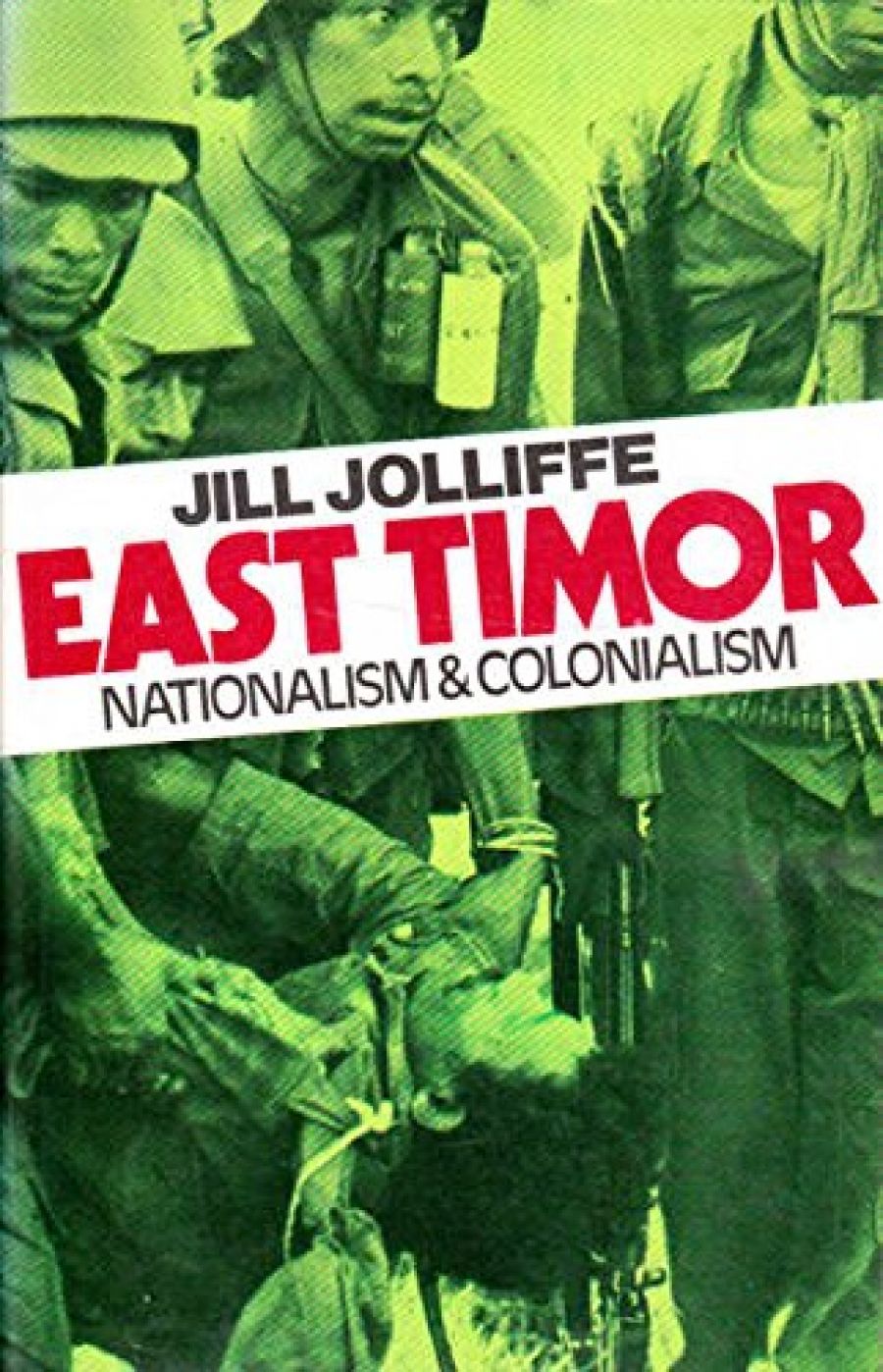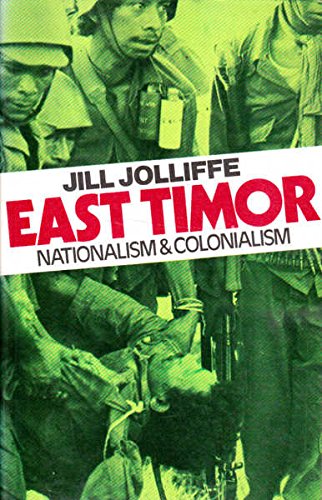
- Free Article: No
- Contents Category: East Timor
- Review Article: Yes
- Article Title: Bloody Colonial Ending
- Online Only: No
- Custom Highlight Text:
A curious fact of modern history is that it seems to take a single decade, sometimes less, for an exploited or colonised people to become, in turn, exploiters or colonisers. This is especially true in Asian history: the Chinese conquest of Tibet, the forceful takeover by India of Portuguese Goa and more recently, in 1975, the military campaign launched by Indonesian forces against East Timor.
- Book 1 Title: East Timor
- Book 1 Subtitle: Nationalism and Colonialism
- Book 1 Biblio: Queensland University Press, 362pp., illus., maps, index, $16.16 hb. ISBN 0 7022 1480 9 hb. ISBN 0 7022 1481 7 pb.
- Book 1 Cover Small (400 x 600):

- Book 1 Cover (800 x 1200):

Jolliffe has taken pains to start at the beginning, tracing the some-400 years of Portuguese colonialism of East Timor. She has pieced together historical, colonial and national shreds until we gain the picture of the fabric of East Timor, a country that, before the coup and the accompanying deaths of five Australian newsmen in Balibo, had hardly impinged onto the Australian consciousness, despite its being only 620 kilometres north of us, Darwin ‘s close neighbour.
East Timor is written with a cool impartial clarity which I suspect took effort on Jolliffe’s part. Occasionally the mask slips and she shows her affection for the East Timorese, her anger at the savagery of their invasion.
Her writing however does make it easy to relate the events and background that contributed to the Portuguese withdrawal and the subsequent Indonesian annexation.
Timor being something of a racial meeting point – Malay and Melanesian predominate as well as strains of Chinese, Arab and African, the last brought as slaves or conscript soldiers by the Portuguese, - it is surprising that there evolved only three main political parties.
These were the pro-Lisbon-Colonial UDT, the pro-Indonesian APODETI and the nationalistic FRETILIN front; it was the Fretilin front, composed mainly of young, Lisbon-educated East Timorese, who finally stood and held briefly against the invaders from the central hills of their homeland’.
Apodeti opposed annexation by Indonesia but desired union with the Republik.
Fretilin, on the other hand wanted self-determination and called for Timorese unity.
Fretilin spokesman Nicolau Lobato described the front as ‘a liberation front, which gathers together people of any ideology who will defend the independence of East Timor ... we are not a Communist party ...’
Perhaps most enlightening, is the chapter on Australia’s role in the East Timor coup; according to Jolliffe, Mr Whitlam ‘s policy of non-intervention acted as a political green light to Indonesian plans to invade. She quotes the letter written by the then Prime Minister which replied to a Labor delegation returned from a visit to East Timor, recommending that the Australian consulate in Dili should be re-opened.
Mr Whitlam had replied that to reopen the consulate could be misinterpreted: ‘political interests in Portuguese Timor could seek to involve us to an extent which I do not feel would be appropriate for Australia.’
More disturbing reading, however, was the account of the way in which the Australian television crew met their deaths, and the poignant photograph of reporter Greg Shackleton painting an ‘Australia’ sign on the outside wail of the house they occupied in Balibo, two days before he died.
Four of the Australians were shot inside the burning house, one had been machinegunned outside, on what was described as ‘a Fretilin escape trail’ by the Indonesian officer in charge of the operation.
The last film in the television camera was never found - did it perhaps show damning proof of what really happened?
The camera itself and some notebooks, including Shackleton’s diary recording their movements to the day before they died, were later handed to the Australian consulate in Jakarta.
Jill Jolliffe, who had previously visited East Timor as a member of a student/trades-union delegation, was among those hastily evacuated to Darwin a few days before the shelling started.
As a special correspondent for the Melbourne Age, she talked and listened to the straggling refugees fleeing East Timor, including the last frantic SOS call over Red Cross radio from Fretilin leader Alarico Fernandes ... ‘Indonesian forces have been landed in Dili by sea, by air ... they are dropping paratroopers … women and children are going to be killed by Indonesian forces ... SOS, we call for your help.’
Darwin never answered.


Comments powered by CComment